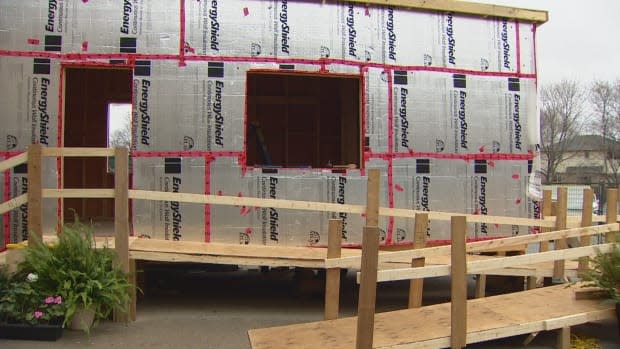'The coolest thing I've ever worked on': GTA students building tiny homes for Indigenous communities

High school students in the Greater Toronto Area are helping to build tiny homes for Indigenous people in Ontario as part of a class project that one Grade 11 student describes as "really eye opening."
The pilot program run by Habitat for Humanity Halton-Mississauga-Dufferin not only gives students hands-on experience in the skilled trades, but also helps to address a housing shortage in Indigenous communities, according to Peter Oliveira, the group's project manager of tiny home construction.
"Students get an opportunity to see the whole construction process instead of just being inside a construction classroom where they might get to build a birdhouse," Oliveira said on Friday.
"What's really awesome is the value of this program goes all the way to actually helping families. Somebody is going to end up in this home that was built by students."
A number of schools in Halton and Peel regions are involved as part of their classroom curriculum.

Each tiny home, a mere 250 square feet, has a main room that serves as a kitchen, dining room, living room and bedroom. It has a bathroom with a shower and it has a HVAC closet. The main room has a Murphy bed that folds out at night. There is radiant floor heating.
"This house has really got everything. It's small but it has what it needs to provide for a family," Oliveira said.
Habitat for Humanity Halton-Mississauga-Dufferin is affiliated with Habitat for Humanity Canada, a national charitable organization known for building homes for people in need. It believes everyone should have a decent and affordable place to call home.
Oliveira said students in the construction program are learning skills like how to install drywall, how to frame walls and how to do finish work. The program brings in subcontractors to do "higher liability work," such as electrical, roofing and plumbing work, he said.
For Ava Sunderland, a Grade 11 student at Notre Dame Catholic Secondary School in Burlington, Ont., working on building a tiny home has been a rewarding experience because she learned not only about building a home but about truth and reconciliation with Indigenous peoples. She said she may go into the trades now.
"This is probably the coolest thing I've ever worked on," she said. "I've always wanted to help people. This is really eye-opening."

She said she told her mother, Amanda Sunderland, a lease administration specialist in corporate real estate at Meridian Credit Union, about the project. Her mother told her employer, and Meridian decided in the fall to contribute $100,000 toward the building of the home at Ava's school.
"It just spiraled from a construction class that she took on a whim and potentially changed her career path," Amanda Sunderland said.
"It's obviously huge for all of us to give back and I'm lucky to be a part of it. If one house can accommodate a family that doesn't have one, that's huge."
1 home completed in 2 semesters
Eden Grodzinski, CEO of Habitat Halton-Mississauga-Dufferin, said it takes two semesters to complete a home.
"These are homes that we've designed in partnership with Indigenous communities," he said. "These projects would not be possible without the support of strong corporate partnerships through Habitat for Humanity."
The pilot program has two phases and five homes are built in each phase. In the first phase, which took place in 2021-22 and involved more than 300 high school students in Grades 10 to 12, the homes went to the Chippewas of Nawash Unceded First Nations.
In the second phase, which is taking place in 2022-23, the homes will go to the Saugeen First Nations in the Bruce Peninsula and The Chippewas of Kettle and Stony Point in Sarnia Lambton. More than 400 students are taking part.
According to Habitat Halton-Mississauga-Dufferin, schools participating in components of the program include:
Holy Trinity and Corpus Christi Catholic Secondary Schools in the Halton Catholic District School Board.
M.M. Robinson High School, Milton District High School, Garth Webb Secondary School and Georgetown District High School in the Halton District School Board.
Brampton Centennial, Judith Nyman and Rick Hansen Secondary Schools in the Peel District School Board.

 Yahoo Movies
Yahoo Movies 